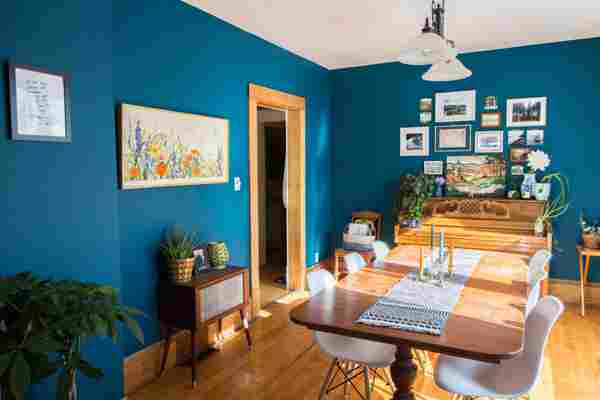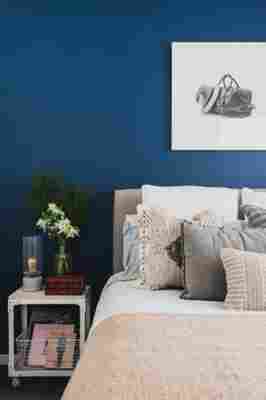10 Paint Mistakes Designers Want You to Stop Making

It doesn’t matter if you choose an easy, breezy neutral paint color or go for a bright, bold hue, choosing a paint color is one of the most important decoration decisions you’ll make for your space. One false shade, trim, or finish, and your room might earn a one-way ticket to design disaster.
Sure, beauty is in the eye of the beholder, and your paint shade is no exception. However, there are some classic mistakes design experts are really, really tired of seeing. To ensure your walls turn heads—in a good way, that is—here are 10 paint mistakes you need to stop making, stat, and easy solutions for each.

Those Baby Hues
Many designers feel that you’re too old for baby blue and pink once you can do basic arithmetic.
“I cringe when I see baby blue walls,” explains Alessandra Wood, interior design expert and vice president of style at Modsy. “Light blues easily run into nursery territory, which makes the space feel childish. “
But just because you’re too old to coat your walls in a juvenile blue doesn’t mean you should nix the color altogether. After all, blue is known for its calming effect, which is essential in any home. Instead, Wood recommends opting for a more saturated shade or incorporating baby blue accents. The result? A fresh space that’s impactful but not too youthful. Honestly though, if you love a paler shade of blue or pink, we recommend balancing out its youthful effect with more mature accents.
Not Going Toward the Light
This just in: Your paint chips are lying to you. Okay, let us explain. A swatch is the best way to sample a color before you break out the paintbrush; however, the exact hue will vary ever so slightly when you finally add a coat to your wall.
“Remember that when picking a color, go for a lighter shade,” says Jill Johnson and Suzanne Ascher, co-founders of Waterleaf Interiors. “It always goes on darker than it looks.”
If you find a paint chip you really love, opt for a shade or two lighter. Trust us, you and your walls will thank us.
Test it Out
Find a color you like? It’s always a good idea to test it out first—and record how it looks at all hours of the day.
“Light plays a huge part in how a color is perceived and so are the materials around it,” explains Elizabeth Sesser, interiors associate at Ike Kligerman Barkley. “You want to see how your selection actually looks in your space.”
For the best results, swatch a teeny, tiny paint on each of your four walls. Don’t forget to check out your walls in the morning, afternoon, and night.
Axe the Accents
While we don’t think accent walls are going out of trend anytime soon, some designers believe they’ve already had their day in the sun.
“If you’re going to go through the effort of painting, do the whole room,” adds Sesser. “Just the single wall makes the space feel unfinished.”
If you do want to make a statement with a bold color, go big or go home! As Carrie Bradshaw said about Mr. Big’s accent wall, “It’s a good idea in theory, but somehow it doesn’t quite work.”
The Softer Side
Of course, if you are going to add an accent wall to your space, make sure you pick a hue that opens up the room.
“For smaller rooms, I love doing a cool accent wall to keep the room feeling open and fresh,” says Cynthia Cornell, an EasyCare color expert. “A soft blue, gray, or green can bring much-needed interest to a small room, while maintaining the calming integrity of the space.”
Cornell recommends soothing shades like EasyCare’s Cucumber Salad and Misty Harbor.
The Trim Treatment
When applying a fresh coat of space to your space, there’s a good chance you deprioritize the color of your trim and crown molding. After all, doesn’t the color of your actual walls take precedent?
In reality, your accent hues matter just as much as the color of your actual walls.
“When it comes to painting a room, we often picture the walls as the only canvas,” Cornell adds. “To ensure your room gets a complete transformation, consider the color you’re going to paint the baseboards, trim, and crown molding. Trim takes time and is worth the effort.”
Up your painting game with these unique trims.
Inaccurately Taking Inventory
The only thing that can outdo having too little paint is spending a small fortune on several gallons that haven’t even been opened. Cornell recommends all dwellers to strike a balance by calculating how much paint they actually need.
“Consider what color you are covering,” she adds. “Very dark and very light colors can take more than one coat.”
Cornell says EasyCare’s Paint Calculator makes it easy to figure exactly how much lacquer you’ll need. Simply enter your dimensions and it’ll churn out a number.
Tricky Touch-Ups
Some renters are allowed to paint their temporary place, provided they bring the room back to its normal hue before they move out. Problem is, after a couple of years, it can hard to remember what the original shade even was.
Before you even break out the brush, record your home’s original shade—or at least what it looks like.
“An easy way to note the color of a room or an accent wall is to unscrew the switch plate on the wall and document the color on the back of it,” Cornell recommends. “Place the screw plate back on and the color is easily remembered.”
Now that’s one easy way to get on your landlord’s good side!
Conscientious Ceilings
Repeat after us: Your ceiling is just as important as the other four walls. So if you want a place that’s painted to perfection, keep your ceiling in mind—right down to the finish.
“Never use anything but flat paint on a ceiling where light reflects even more than on walls, showcasing shadows and uneven drywall like crazy,” says Caitlin Murray, interior designer and founder of Black Lacquer Design.
Instead, a low-luster sheen will successfully mask your ceiling’s flaws.
Forgetful Finish
A matte or gloss finish is the perfect final touch to any space, but that doesn’t mean it should be an after-thought. In reality? The finish you use can make or break your room
“Paint comes in a handful of finishes from flat to a high gloss,” Sesser says. “Selecting the right one for your space or application is key!”
Instead, consider which finish you should choose before you apply the primer. Not sure how to choose between a matte or gloss finish? Check out our tips here.
Your comment